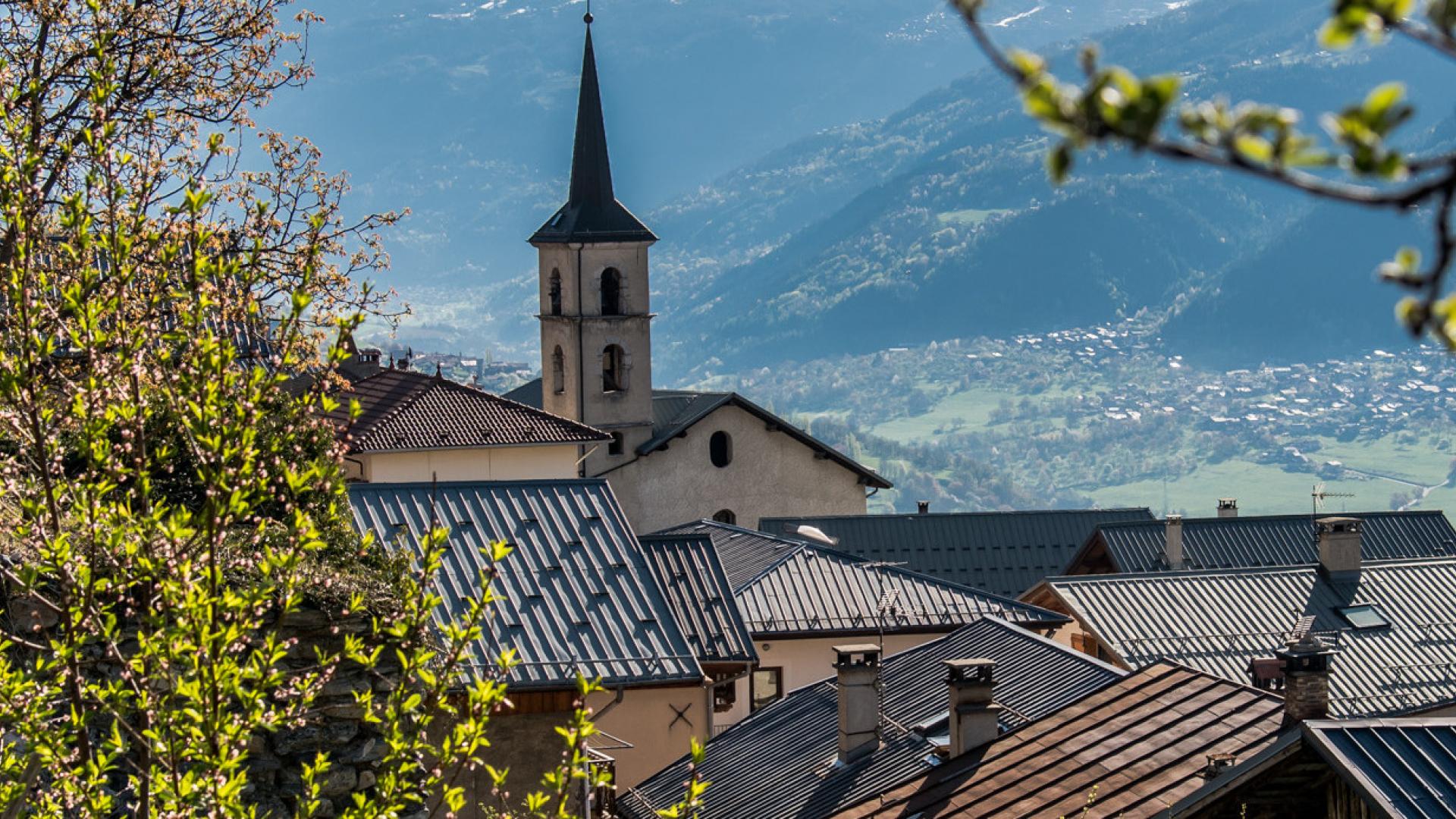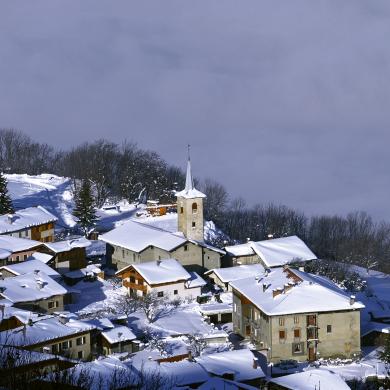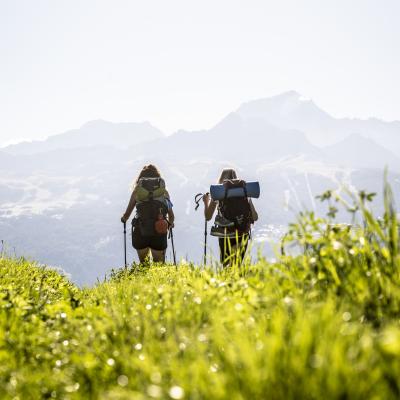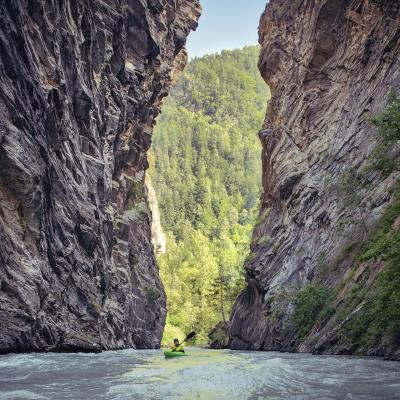Centron - Montgirod
Centron is situated just a few kilometres from Aime la Plagne. With the Isère river running alongside, it is the ideal place for white water sports. Its leisure park comprises a lake, games for children, picnic areas with barbecues and Le Chalet snack bar. Centron also proposes three trails on the themes of botany, ecology and geology. The village has the only example of a 20th century church in La Plagne.
Montgirod, on the sunny slopes above, overlooks Centron. In the village centre stands Saint-Laurent’s church which survived a fire started by German troops in 1944. Saint Laurent is celebrated every year in August. Before coming back down to the valley, make a detour to the hamlet of Villaret and visit Saint Jean Baptiste’s chapel. At 720 metres, it houses a remarkable altarpiece studded with baroque decoration.
Villette
Villette is a village in the valley, just a few minutes from Aime la Plagne, dominated by the Chateau Saint-Anne, built on a rocky outcrop. There is a marble quarry here where Blue Savoy marble is extracted. Famous for its quality, this marble was used for the floor tiles in Les Halles in Paris, the huge counter of Michelin-starred chef Laurent Petit in his Annecy restaurant, Le Clos des Sens, and in Oriental palaces.
Villaroland
This little village is situated on the Versant du Soleil, 2 kilometres from Aime la Plagne. It is a peaceful place with views over the valley of Aime. It was an important hamlet in times gone by so it has its own chapel, Saint Eustache, with rare medieval architecture, which houses remarkable restored frescos dating back to the 15th century.
Granier
Granier and its main hamlet, La Thuile, are perched at 1250 metres on the Versant du Soleil. Overlooking the valley, you enjoy an exceptional panorama of the Paradiski area as well as plenty of sunshine. The village centres around the baroque church of Saint-Barthélémy. The Tourist Information centre offers information, some groceries, bread and newspapers (on request). Just over the road, the Auberge de Granier is a great place to get a meal or just stop for a drink. It’s impossible to miss the bread oven with its restored facade which is lit during village festivities, offering an opportunity to try some bread that is still hot or a crinchin, a delicious aniseed-flavoured brioche. Several of the locals propose comfortable gîtes where you will be welcomed like friends. In winter, above the village, there is a play area where you can enjoy the snow with a toboggan run, snowshoe itineraries and cross-country trails. In holiday periods, go into Prachanié refreshment bar for a crêpe or a hot wine. In summer, don’t miss the Alpages de Plan Pichu, a hike that offers an opportunity to meet shepherds and herdsmen who are still making Beaufort d’Alpage cheese in the traditional manner.
La Côte d'Aime- Montméry
La Côte d’Aime consists of several hamlets between Aime La Plagne and the famous Pierra Menta. The south-facing slopes benefit from maximum sunshine in summer and winter alike. The main hamlet has a Tourist Information Centre, not far from the baroque church of Saint Laurent and its botanical garden. La Côte d’Aime is the ideal place for finding out about life here in olden times. You can pretend to be a pupil from the beginning of the 20th century at the Old-Time School, sitting on a bench and leafing through exercise books or picking up a pen in the reconstituted classroom. The village dairy closed in 1970, but a museum has put together objects connected with cheese-making and the Alpine pastures and there is a shop where you can purchase local products: cheeses, crozets (Savoyard pasta squares), jams and craft items. Several artists (painters, sculptors, water colourists) live on the Versant du Soleil and some of them have opened their workshops to the general public.
As you leave La Côte d’Aime, head towards Montméry. Along the way, you can admire Saint-Jacques’ chapel. Like a sentinel with its white façade, it can be seen from quite a distance. The small village that is typical of the hamlets you see on the south-facing slope of the Tarentaise has a dairy. You can admire the large copper cauldron where the Beaufort cheese was made and the notebooks where the weight of the milk delivered was listed. When you enter the Maison de Joannès, it’s like going back to an earlier time when men and beasts lived in the same house. Joannès exhibits familiar objects from his own childhood, as well as those of his parents and grandparents. Saint Etienne’s chapel is in the village centre.
Valezan
Valezan is one of the picturesque villages perched on the Versant du Soleil. 13 kilometres from Aime and 1200 metres above sea level, the village offers lovely views of Mont Pourri and La Plagne. The clock tower of St François de Salles church (early 18th century) rises up above the traditional houses. The village has a number of gites and an inn. The Auberge de Valezan is the village’s nerve centre with rooms, a restaurant (with a south-facing terrace), a small grocery store for basic supplies, bread and local products. In the village streets, you can see architectural treasures that have been carefully restored by the locals: pillared houses (with an inner courtyard), stone arches, roofs and chimneys made of lauze stone, doors with sculpted panels...
Situated on the GR5 and the Baroque trail, Valezan is the perfect base camp for hiking, snowshoeing, cross-country skiing or ski touring.
Bellentre
On the road from Aime La Plagne to La Plagne Montchavin les Coches, you shouldn’t miss the village of Bellentre and its onion-shaped clock tower. In front of the church, there is a cross sculpted in Villette marble that dates back to 1756. Look above the pediment to see a statue of a cockerel, the symbol of Bellentre.
Macôt-la-Plagne
You have to pass through Macôt-la-Plagne to reach the altitude sites of la Plagne. The village in the valley is the administrative centre of the commune of La Plagne Tarentaise. Saint-Nicolas’ church with its onion-shaped clock tower in the village centre overlooks narrow streets and old houses. There is a small supermarket/Post Office and a public library. Macôt-la-Plagne is surrounded by fields and orchards where apples, pears and walnuts grow.
Longefoy
A traditional Savoyard village situated a few kilometres from the slopes of La Plagne Montalbert. The red-tiled roofs are dominated by La Superga chapel. Built on a hill in 1853, this is a smaller version of the famous Superga sanctuary near Turin. The village houses several gîtes, a bakery and a hotel-bar-restaurant. Several times a year, the locals light the village bread oven, a great opportunity to enjoy some bread while it’s still hot, or a crinchin, a delicious aniseed-flavoured brioche.
At 1500 metres, Montgésin hamlet is worth a detour to see its chapel, Notre Dame des Neiges, which has rich mural paintings and a wrought iron grid that dates back to 1758. Many elements (including the altarpiece) have been restored, thanks to the intervention of thirty or so volunteers.
Montorlin
Montorlin is a little village on the road to Montchavin, between hayfields and forests, with a lovely view of the Tarentaise valley and the Versant du Soleil. It has traditional streets and the small chapel dedicated to St. Clair.
The traditional villages
Up above the right bank of the Isère river rises the Versant du Soleil. Granier, La Côte d’Aime and Valezan are on sunny, south-facing terrain, favourable to mixed farming. A remarkable number of old buildings still stand. Take the time to wander through the villages with these large houses and climb up to the mountain pastures to admire the summer chalets. These constructions bear witness to the collective wealth that is also found in the numerous religious buildings.
The vineyards
Vineyards shape the landscape of the Versant du Soleil, rising to 800 m above sea level. They hark back to a peasant society that was self-sufficient. Today, several dozen hectares are still cultivated by heroic winegrowers. In La Côte d’Aime, the motivated winegrowers have a modern wine press, so they can make quality wine or just bring part of their harvest.
The Aime Tulip
This protected tulip is a remarkable example of a microendemic species that originated a very long time ago and has persisted in the local agricultural land. The Aime Tulip, “Tulipa Aximensis”, comes from the latin Axima which was the Gallo-Roman name for the former capital of the Tarentaise.
The flowers used to grow on a 300m2 piece of land near the Croix d’Aime, where they were last seen in 1970, before disappearing when a housing development went up. Before the building work started, some bulbs were taken and cultivated by Dutch horticulturists and private growers, who preserved the species. The tulip has become the symbol of the commune of Aime. It can grow to a height of over 30 cm. Its leaves are flat or slightly wavy and blue-green in colour. The bulb is small and brown coloured. The perianth is quite closed, in the form of a potbellied bell and is a deep red with a white base. The petals are erect and cup shaped with a pointed tip. The outer petals are elliptic while the inner ones are rounder.








